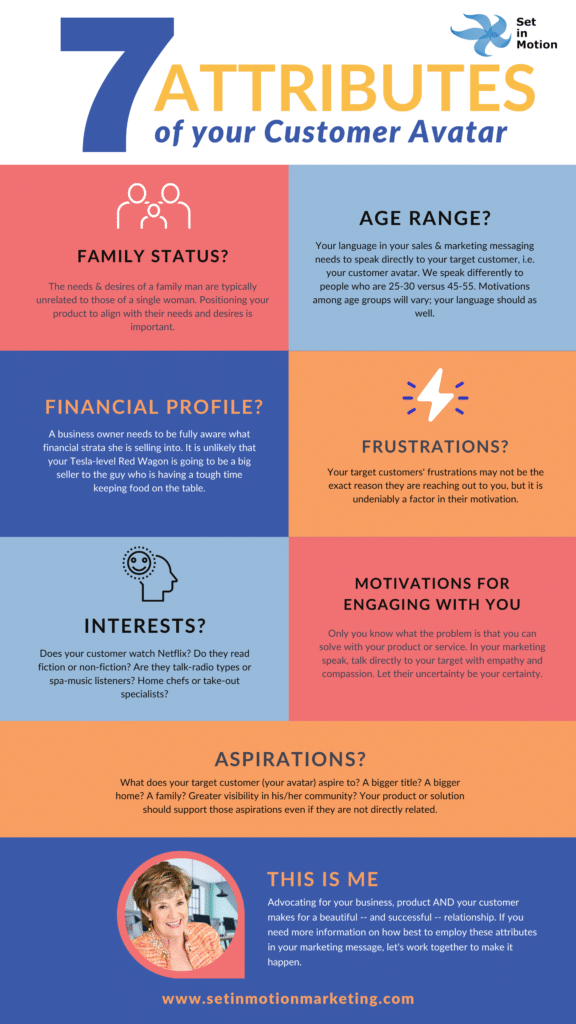The pandemic caused customers, clients and colleagues to shift to digital channels versus our desired-state of face-to-face interaction. With that shift, the expectation is even higher for brands to deliver a personalized experience. In email marketing, advertising, and social media.
Customers, clients, and colleagues want to feel like brands (yes, yours and mine) have an understanding of who they are and what is important to them.
So how do you do that?
The long and the short of it is, well, you get to know your customer. And by “customer” I mean that ideal person that is most likely to purchase your product or service.
There are many attributes to contribute to that ideal customer’s persona, both demographics and psychographics. Both are vital data to you and to the formulation of your message.

Without getting too nerdy here, let me briefly explain the two terms:
Demographics: the numbers and statistics that are associated with your ideal customer. Here are a few examples:
• age • identifying gender • financial status • education achieved
Psychographics: the attributes that are psychological in nature
• aspirations • fears • emotional state • ambitions
Okay. That seems simple. Not easy, but simple.
But when you think of your own business and the interactions that you have with you customers, aren’t you getting some of this information already? You may not be asking her directly, “Hello, Mrs. Jones, how many children do you have?” but the family and the current emotional state will frequently come up in conversation.
So that is the point: have conversations with your customers. While they are shopping or sitting in the waiting room, or when they leave feedback on social media or jot a note on their invoice. Have a way of collecting that feedback so that you can build an understanding of those nerdy bits of data: the demographics and the psychographics.
The 7 Attributes infographic below will help guide you along the path of discovery.

Family Status
Did you have the same view of the future when you were single and carefree? Probably not. Those little rug-rats have a way of changing our perspectives and changing our spending habits. It’s important to know if your ideal customer is single, married with kids or an empty-nester.
Age Range
For sure, we have different views when we are 65 than we did when we were 25. There is a high probability that you don’t speak to your 65-year-old customer the same way you do your 25-year-old customer. That should apply to your written content like email marketing and other digital communications as well.
Financial Profile
If your ideal customer is living hand-to-mouth, it is not likely they will be searching for a way to spend big money with anyone, but they are still a customer. Talk to them in their language with sentiment that shows them that you understand their limitations.
Frustrations
If you are a service provider that sees a lot of customers who have already been to someone in your industry but have had a difficult experience, your ideal customer may be a little battered and bruised. Speak to them recognizing they may not have been treated well, but assuring them that not all providers are alike.
Interests
Is your ideal customer apt to do long vacations every year? Or are they so involved with their own businesses that a weekend away is akin to Heaven? Your communication style should accommodate that ideal client’s lifestyle in both brevity and language.

Motivations
Your ideal customers’ motivations are not likely to be too dissimilar for a given service or product. In reviewing the motivations of your top customers, you will quickly discern a pattern among them and be able to speak directly to those issues/wants/desires in your email marketing or other forms of communication.
Aspirations
Does your ideal customer have a desire to be a better person once they have purchased a product or service from you? Do they expect to grow their business or their personal lives through working with you? The closer you can get to their emotional selves, the more likely your message will resonate with your buyer.
Get personal, not invasive. Give them grace and honor, not fear and deceit.
When you’re thoughtful about the way you convey information to customers, that’s likely to have a more immediate and lasting effect than a splashy new logo or 20-percent-off coupon ever could. Give it a try. Ask your customer something more personal; get to know them. And then reflect that new-found knowledge in your email marketing and social posts.


